Thermal Comfort in NZEB Collective Housing in Northern Spain
Abstract
1. Introduction
1.1. Overheating and Health
1.2. Housing Typology in Spain
1.3. The Urban Heat Island Effect
1.4. Spanish Overheating Prevention Standards and Regulations
1.5. Relevant Previous Case Studies
2. Materials and Methods
2.1. Thermal Comfort Models and Standards
2.2. User Comfort Surveys
2.3. Description of the Case Study
2.4. Data Collection
2.5. Outdoor Climatic Data Collection and Analysis
- General cool environment (69% of the hours below 20 °C), with few hours above 25 °C (7.2%) and less hours above 28 °C (2.6%)
- The maximum temperature, 37.5 °C, was recorded in June
- The hottest month, on average, was August
- High environmental humidity. The maximum relative humidity of all months was 98%. Relative humidity remained above 70% for 72.7% of the summer hours.
3. Results
3.1. Post-Occupancy Evaluation Survey
3.2. Results of the Monitoring Campaign
3.2.1. Apartment 1. Comfort Analysis. Period 1 (1 April 2019–31 March 2020)
- The first criterion, Hours of Exceedance (He) limited to 3% of occupied hours, is met.
- The second criterion, Daily Weighted Exceedance (We), is met.
- The third criterion, Upper Limit Temperature (Tupp), which that the maximum adaptative temperature limit should never be exceeded by more than 4 degrees Celsius, is met.
3.2.2. Comparative Comfort Analysis for the 6 Monitored Apartments. Period 2 (1 October 2019–30 October 2020)
4. Discussion and Conclusions
Author Contributions
Funding
Acknowledgments
Conflicts of Interest
References
- Directive 2010/31/EU of the European Parliament and of the Council of 19 May 2010 on the energy performance of buildings. Off. J. Eur. Union 2010, 3, 124–146.
- Commission Recommendation (EU) 2016/1318 of 29 July 2016 on Guidelines for the Promotion of Nearly Zero-Energy Buildings and Best Practices to Ensure That, by 2020, All New Buildings are Nearly Zero-Energy Buildings. Available online: https://eur-lex.europa.eu/legal-content/EN/TXT/?uri=CELEX%3A32016H1318 (accessed on 1 October 2020).
- Hermelink, A.; Schimschar, S.; Boermans, T.; Pagliano, L.; Zangheri, P.; Armani, R.; Voss, K.; Musall, E.; Ecofys. Towards Nearly Zero-Energy Buildings. Definition of Common Principles Under the EPBDFinal ReportEcofys. 2012. Available online: https://ec.europa.eu/energy/sites/ener/files/documents/nzeb_full_report.pdf (accessed on 1 October 2020).
- Ministères de la Transition Ecologique, France. Réglementation Thermique RT-2020. Available online: https://www.rt-batiment.fr/ and http://www.batiment-energiecarbone.fr/; (accessed on 1 October 2020).
- Fletcher, M.J.; Johnston, D.K.; Glew, D.W.; Parker, J.M. An empirical evaluation of temporal overheating in an assisted living Passivhaus dwelling in the UK. Build. Environ. 2017, 121, 106–118. [Google Scholar] [CrossRef]
- Sameni, S.M.T.; Gaterell, M.; Montazami, A.; Abdullahi, A. Overheating investigation in UK social housing flats built to the Passivhaus standard. Build. Environ. 2015, 92, 222–235. [Google Scholar] [CrossRef]
- Rory, V.J.; Goodhewb, S.; de Wilde, P. Measured indoor temperatures, thermal comfort and overheating risk: Post-occupancy evaluation of low energy houses in the UK. Energy Procedia 2016, 88, 714–720. [Google Scholar] [CrossRef]
- Mitchell, R.; Natarajan, S. Overheating Risk in Passivhaus Dwellings. Building Services Engineering Research and Technology. Sage J. 2019, 40, 446–469. [Google Scholar] [CrossRef]
- Mcleod, R.S.; Hopfe, C.J.; Kwan, A. An Investigation into Future Performance and Overheating Risks in Passivhaus Dwellings. Build. Environ. 2013, 70, 189–209. [Google Scholar] [CrossRef]
- Larsen, T.S.; Jensen, R.L. Comparison of measured and calculated values for the indoor environment in one of the first Danish Passive houses. In Proceedings of the Building Simulation 2011: 12th Conference of International Building Performance Simulation Association, Sydney, Australia, 14–16 November 2011. [Google Scholar]
- Carrilho, D.G.; Augusto, A.; Lerer, M.M. Solar Powered Net Zero Energy Houses for Southern Europe: Feasibility Study. Sol. Energy 2012, 86, 634–646. [Google Scholar] [CrossRef]
- Causone, F.; Tatti, A.; Pietrobon, M.; Zanghierlla, F.; Pagliano, L. Yearly Operational Performance of a nZEB in the Mediterranean Climate. Energy Build. 2019, 198, 243–260. [Google Scholar] [CrossRef]
- Costanzo, V.; Fabbri, K.; Piraccini, S. Stressing the Passive Behavior of a Passivhaus: An Evidence-Based Scenario Analysis for a Mediterranean Case Study. Build. Environ. 2018, 142, 265–277. [Google Scholar] [CrossRef]
- Colclough, S.; Kinnane, O.; Hewitt, N.; Griffiths, P. Investigation of nZEB social housing built to the Passive House standard. Energy Build. 2018, 179, 344–359. [Google Scholar] [CrossRef]
- Morey, J.; Beizaee, A.; Wright, A. An investigation into overheating in social housing dwellings in central England. Build. Environ. 2020, 176, 106814. [Google Scholar] [CrossRef]
- Rodriguez Vidal, I. Evaluation of the Passivhaus Construction Standard and its Application in the Climatic Environment of the Basque Autonomous Community and the Navarra Foral Community. Ph.D. Thesis, University of the Basque Country, Leioa, Spain, 12 April 2016. [Google Scholar]
- Kovats, S.; Hajat, S. Heat stress and public health: A critical review. Annu. Rev. Public Health 2008, 29, 41–55. [Google Scholar] [CrossRef] [PubMed]
- Fouillet, A.; Rey, G.; Laurent, F.; Pavillon, G.; Bellec, S.; Guihenneuc-Jouyaux, C.; Clavel, J.; Jougla, E.; Hemon, D. Excess mortality related to the August 2003 heat wave in France. Int. Arch. Occup. Environ. Health 2006, 80, 16–24. [Google Scholar] [CrossRef] [PubMed]
- Vautard, R.; Boucher, O.; van Oldenborgh, G.J.; Otto, F.; Haustein, K.; Vogel, M.M.; Seneviratne, S.I.; Soubeyroux, J.M.; Kreienkamp, F.; Stott, P.; et al. Human Contribution to the Record-Breaking July 2019 Heat Wave in Western Europe. Available online: https://www.ipsl.fr/en/News/News-releases/Human-contribution-to-the-record-breaking-July-2019-heat-wave-in-Western-Europe (accessed on 16 November 2020).
- Kosatsky, T. The 2003 European Heat Waves. Eurosurveillance 2005, 10, 1–9. [Google Scholar] [CrossRef]
- Instituto Nacional de Estadística. Statistics National Institute. Press Release. 24 November 2005. Available online: https://www.ine.es/prensa/np393.pdf (accessed on 1 October 2020).
- WHO. Heat-Waves: Risks and Responses; Health and Global Environmental Change Series No. 2, Energy, Environment and Sustainable Development: Copenhagen, Denmark, 2004; Available online: https://www.euro.who.int/__data/assets/pdf_file/0008/96965/E82629.pdf (accessed on 1 October 2020).
- Menne, B.; Matthies, F. Improving Public Health Responses to Extreme Weather/Heat-Waves: EuroHEAT; WHO: Copenhagen, Denmark, 2009; Available online: https://www.euro.who.int/__data/assets/pdf_file/0010/95914/E92474.pdf?ua=1 (accessed on 1 October 2020).
- Ministerio de Sanidad y Consumo. Plan Nacional de Actuaciones Preventivas de los Efectos del Exceso de Temperaturas Sobre la Salud. Available online: https://www.mscbs.gob.es/ciudadanos/saludAmbLaboral/planAltasTemp/2020/Plan_nacional_actuaciones_preventivas.htm (accessed on 1 October 2020).
- EUROSTAT Statistics Explained. Statistics on Housing. Available online: https://ec.europa.eu/eurostat/statistics-explained/index.php?title=Housing_statistics/es#Tipo_de_vivienda (accessed on 1 October 2020).
- Eustat-Euskal Estatistika Erakundea-Instituto Vasco de Estadística. Available online: https://www.eustat.eus/elementos/ele0017300/a-1-de-enero-de-2019-el-numero-de-viviendas-en-la-ca-de-euskadi-habia-crecido-en-5/not0017383_c.html (accessed on 1 October 2020).
- The Hague: Ministry of the Interior and Kingdom Relations. Housing Statistics in the European Union; Dol, K., Haffner, M., Eds.; OTB Research Institute for the Built Environment, Delft University of Technology: Delft, The Netherlands, September 2010.
- Instituto Nacional de Estadística. Statistics National Institute. Continuous Household Survey. 2019. Available online: https://www.ine.es/dyngs/INEbase/es/operacion.htm?c=Estadistica_C&cid=1254736176952&menu=ultiDatos&idp=1254735572981#:~:text=La%20Encuesta%20continua%20de%20hogares,de%20las%20viviendas%20que%20habitan (accessed on 1 October 2020).
- Instituto Nacional de Estadística. Statistics National Institute. Census 2011. Available online: https://www.ine.es/censos2011_datos/cen11_datos_inicio.htm (accessed on 1 October 2020).
- Acero, J.A.; Arrizabalaga, J.; Kupski, S.; Katzschner, L. Urban heat island in a coastal urban area in northern Spain. Theor. Appl. Climatol. 2013, 113, 137–154. [Google Scholar] [CrossRef]
- Gobierno Vasco, Departamento de Vivienda y Asuntos Sociales. Ordenanzas de Diseño de Viviendas de Protección Oficial. Boletín Of Gob. Vasco; 2009. Available online: https://www.euskadi.eus/gobierno-vasco/-/eli/es-pv/o/2009/02/12/(1)/dof/spa/html/ (accessed on 1 October 2020).
- Gobierno Vasco. Proyecto de Decreto por el que se Regula las Condiciones de Habitabilidad y las Normas de Diseño de las Viviendas y Alojamientos Dotacionales en la Comunidad Autónoma del País Vasco. Available online: https://www.euskadi.eus/informacion_publica/proyecto-de-decreto-por-el-que-se-regula-las-condiciones-de-habitabilidad-y-las-normas-de-diseno-de-las-viviendas-y-alojamientos-dotacionales-en-la-comunidad-autonoma-del-pais-vasco/web01-tramite/es/ (accessed on 1 October 2020).
- Código Técnico de la Edificación. Documento Básico Ahorro de Energía HE1: Limitación de la Demanda Energética. Madrid. December 2019. Available online: https://www.codigotecnico.org/DocumentosCTE/AhorroEnergia.html (accessed on 1 October 2020).
- Código Técnico de la Edificación. Herramienta Unificada Lider-Calener (HULC). Available online: https://www.codigotecnico.org/Programas/HerramientaUnificadaLIDERCALENER.html; (accessed on 1 October 2020).
- Instituto Nacional de Estadística. Statistics National Institute. Household and Environment Survey 2008Housing. Available online: https://www.ine.es/jaxi/Tabla.htm?path=/t25/p500/2008/p01/l0/&file=01013c.px&L=0 (accessed on 1 October 2020).
- Idealista Home Sales Website. Study of the Percentage of Homes with Air Conditioning for Sale in 2018. Available online: https://www.idealista.com/news/inmobiliario/vivienda/2018/07/17/766582-solo-un-31-de-las-casas-en-espana-tiene-aire-acondicionado (accessed on 1 October 2020).
- Zero Carbon Hub. Overheating in Homes, The Big Picture; Full Report; Zero Carbon Hub: London, UK, 2015; Available online: http://www.zerocarbonhub.org/sites/default/files/resources/reports/ZCH-OverheatingInHomes-TheBigPicture-01.1.pdf (accessed on 1 October 2020).
- Public Health England. Heatwave Plan for England. 2015; London, UK. Available online: https://assets.publishing.service.gov.uk/government/uploads/system/uploads/attachment_data/file/888668/Heatwave_plan_for_England_2020.pdf (accessed on 1 October 2020).
- Department for Communities and Local Government. Investigation into Overheating in Homes, Literature Review; Department for Communities and Local Government (DCLG): London, UK, 2012; ISBN 9781409835929.
- Department for Communities and Local Government. Investigation into Overheating in Homes, Analysis of Gaps and Recommendations; Department for Communities and Local Government (DCLG): London, UK, 2012; ISBN 978-1-4098-3591-2.
- Department for Environment Food and Rural Affairs. The National Adaptation Programme: Making the Country Resilient to a Changing Climate; Internet; Department for Environment Food and Rural Affairs: London, UK, 2013; ISBN 978-0-10-851238-4. Available online: https://assets.publishing.service.gov.uk/government/uploads/system/uploads/attachment%20data/file/209866/pb13942-nap-20130701.pdf (accessed on 1 October 2020).
- NHBC Foundation. Understanding Overheating–Where to Start: An Introduction for House Builders and Designers; NHBC Foundation: Milton Keynes, UK, 2012. [Google Scholar]
- Pathan, A.; Mavrogianni, A.; Summerfield, A.; Oreszczyn, T.; Daviesa, M. Monitoring summer indoor overheating in the London housing stock. Energy Build. 2017, 141, 361–378. [Google Scholar] [CrossRef]
- Lomas, K.L.; Porritt, S.M. Overheating in Buildings: Lessons from Research. Building Research and Information. Available online: https://doi.org/10.1080/09613218.2017.1256136 (accessed on 1 October 2020).
- Passive House Database. Available online: https://passivehouse-database.org/ (accessed on 1 October 2020).
- Hidalgo, J.M.; Psomas, T.; García-Gáfaro, C.; Heiselberg, P.; Millán, J.A. Overheating Assessment of a Passive House Case Study in Spain, Madrid. Spain, 2015–AIVC. Available online: https://www.aivc.org/sites/default/files/62.pdf (accessed on 1 October 2020).
- Costanzo, V.; Echarri-Iribarren, V.; Sotos-Solano, C.; Espinosa-Fernández, A.; Prado-Govea, R. The Passivhaus Standard in the Spanish Mediterranean: Evaluation of a House’s Thermal Behaviour of Enclosures and Airtightness. Sustainability 2019, 11, 3732. [Google Scholar] [CrossRef]
- Bunyesc, J. Passive house in Mediterranean climate. In Proceedings of the 16th International Conference on Passive Houses, Hannover, Germany, 4–5 May 2012; pp. 365–370. [Google Scholar]
- Attia, S.; Eleftheriou, P.; Xeni, F.; Morlot, R.; Menezo, C.; Kostopoulos, V.; Betsi, M.; Kalaitzoglou, I.; Pagliano, L.; Cellura, M.; et al. Overview and Future Challenges of nearly Zero Energy Buildings (nZEB) Design in Southern Europe. Energy Build. 2017, 155, 439–458. [Google Scholar] [CrossRef]
- AENOR. Ergonomics of the Thermal Environment-Analytical Determination and Interpretation of Thermal Comfort using Calculation of the PMV and PPD Indices and Local Thermal Comfort Criteria (UNE-EN ISO 7730:2005). 2006. Available online: https://global.ihs.com (accessed on 1 October 2020).
- Ministerio de Industria, Energía y Turismo. Reglamento de Instalaciones Térmicas En Los Edificios. Boletín Off. Estado 2007, 207, 35931–35984. [Google Scholar]
- AENOR. Indoor Environmental Input Parameters for Design and Assessment of Energy Performance of Buildings Addressing Indoor Air Quality, Thermal Environment, Lighting and Acoustics (UNE-EN 15251:2008); AENOR: Madrid, Spain, 2008. [Google Scholar]
- Chartered Institution of Building Services Engineers. CIBSE Guide A: Environmental Design; CIBSE: London, UK, 2015; ISBN 9781906846541. [Google Scholar]
- Chartered Institution of Building Services Engineers. The Limits of Thermal Comfort: Avoiding Overheating in European Buildings; CIBSE TM52: 2013; Chartered Institution of Building Services Engineers: London, UK, 2013; ISBN 978-1-906846-34-3. [Google Scholar]
- Chartered Institution of Building Services Engineers. Methodology for the Assessment of Overheating Risk in Homes; CIBSE TM59: 2017; Chartered Institution of Building Services Engineers: London, UK, 2017; ISBN 978-1-912034-18-5. [Google Scholar]
- Mulville, M.; Stravoravdis, S. The impact of regulations on overheating risk in dwellings. Build. Res. Inf. 2016, 44, 520–534. [Google Scholar] [CrossRef]
- Brunsgaard, C. Understanding of Danish Passive Houses based on Pilot Project Comfort Houses. Ph.D. Thesis, Aalborg University, Aalborg, Denmark, 2010. [Google Scholar]
- Schnieders, J. Passive Houses in South West Europe: A Quantitative Investigation of Some Passive and Active Space Conditioning Techniques for Highly Energy Efficient Dwellings in the South West European Region, 2nd ed.; Passivhaus Institut: Darmstadt, Germany, 2009. [Google Scholar]
- Benoit, R.; Watts, D.D.; Dwyer, K.; Kaufmann, C.; Fakhry, S. Windows 99: A Source of Suburban Pediatric Trauma. J. Trauma Inj. Infect. Crit. Care 2000, 49, 477–482. [Google Scholar] [CrossRef] [PubMed]
- Inkarojrit, V. Balancing Comfort: Occupants’ Control of Windows Blind in Private Offices. Ph.D. Thesis, University of California, Berkeley, CA, USA, 2005. Available online: http://citeseerx.ist.psu.edu/viewdoc/download?doi=10.1.1.66.3256&rep=rep1&type=pdf (accessed on 1 October 2020).
- Raja, I.; Nicol, F.; McCartney, K.; Humphries, M. Thermal comfort: Use of controls in naturally ventilated buildings. Energy Build. 2001, 33, 235–244. [Google Scholar] [CrossRef]
- Nicol, F. Characterising occupant behaviour in buildings: Towards a stochastic model of occupant use of windows, lights, blinds, heaters and fans. In Proceedings of the 7th International IBPSA Conference, Rio de Janeiro, Brazil, 13–15 August 2001; pp. 1073–1078. [Google Scholar]
- Bere Architects. Larch House e Soft Landings Stage 4 Initial Aftercare Workshop in Video Interview with the Occupants of the Larch Passivhaus, Ebbw Vale Wales. 2012. Available online: https://bere.co.uk/ (accessed on 1 October 2020).
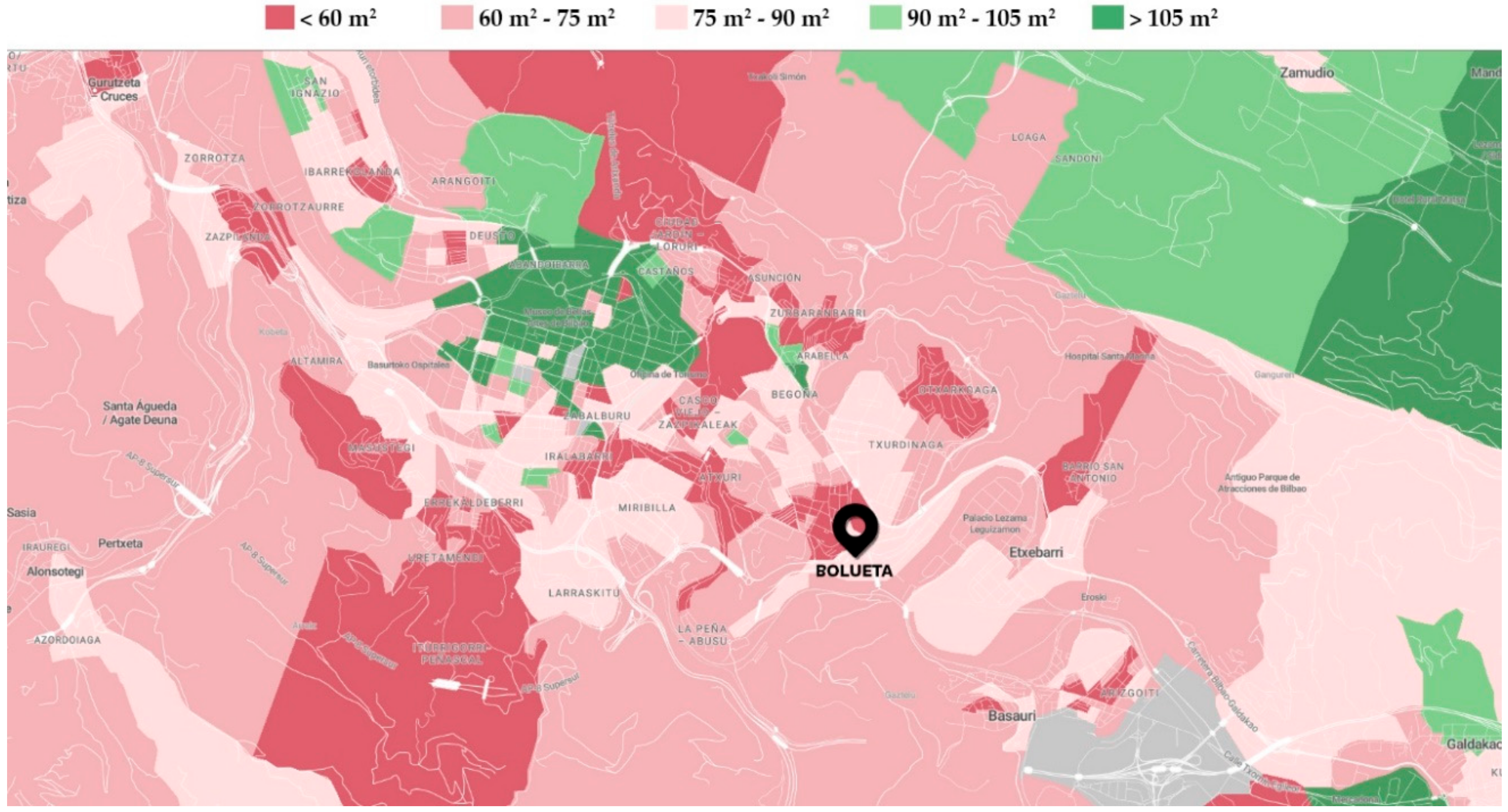

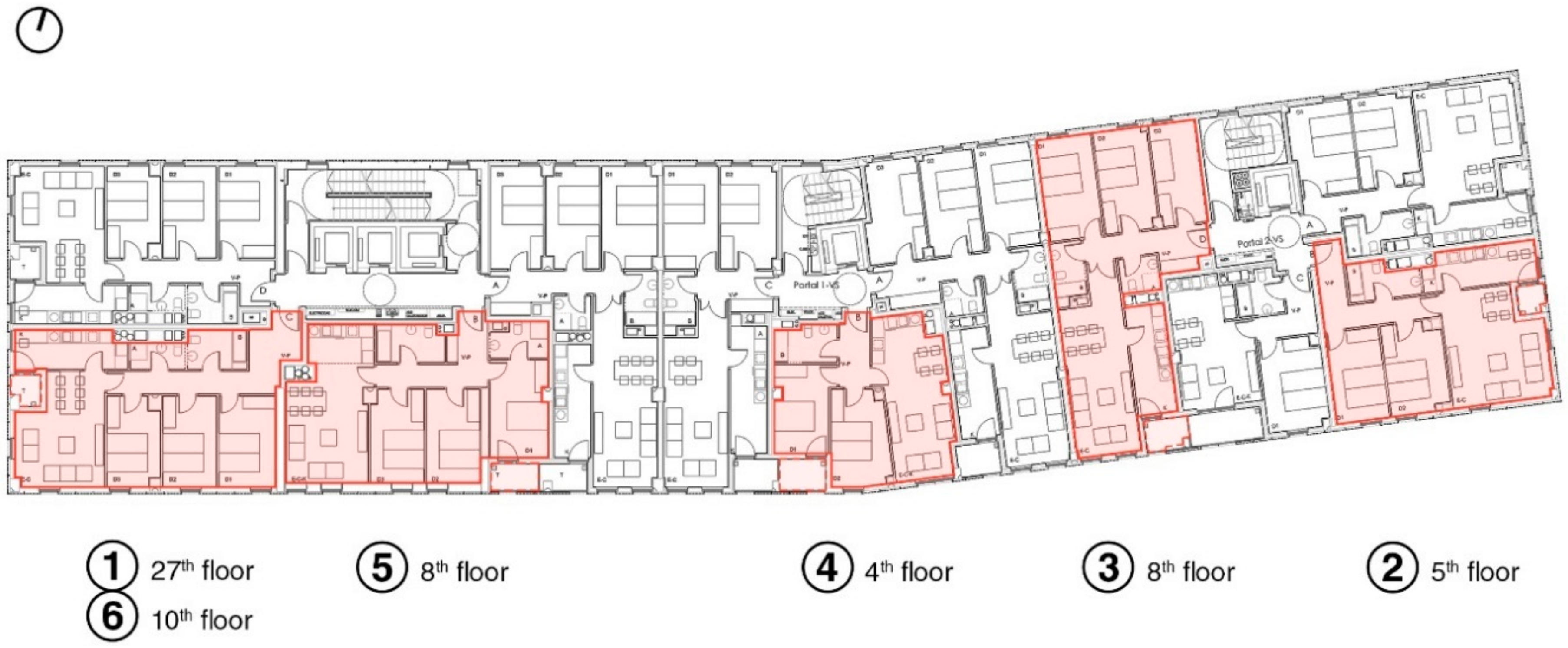
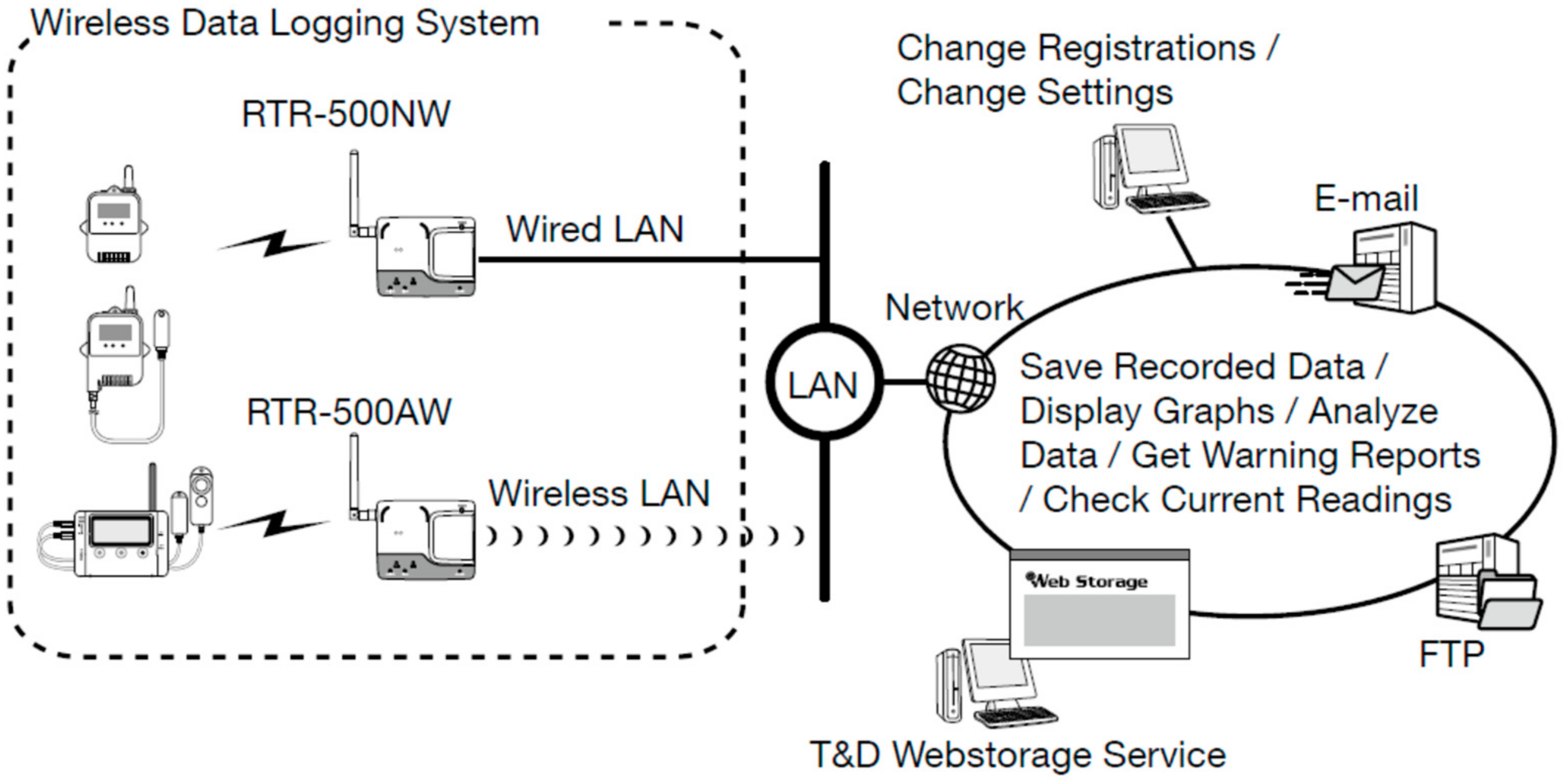

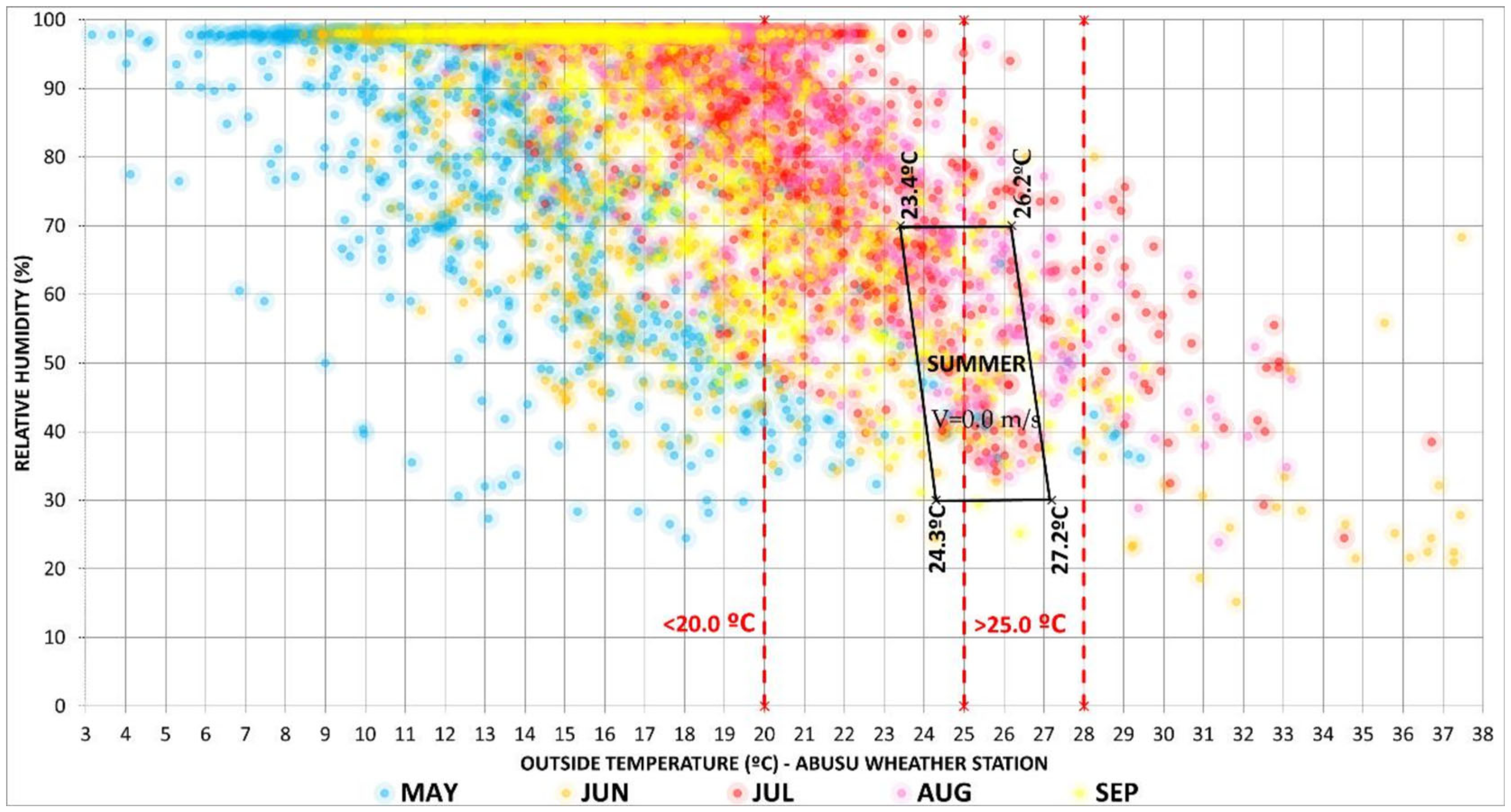
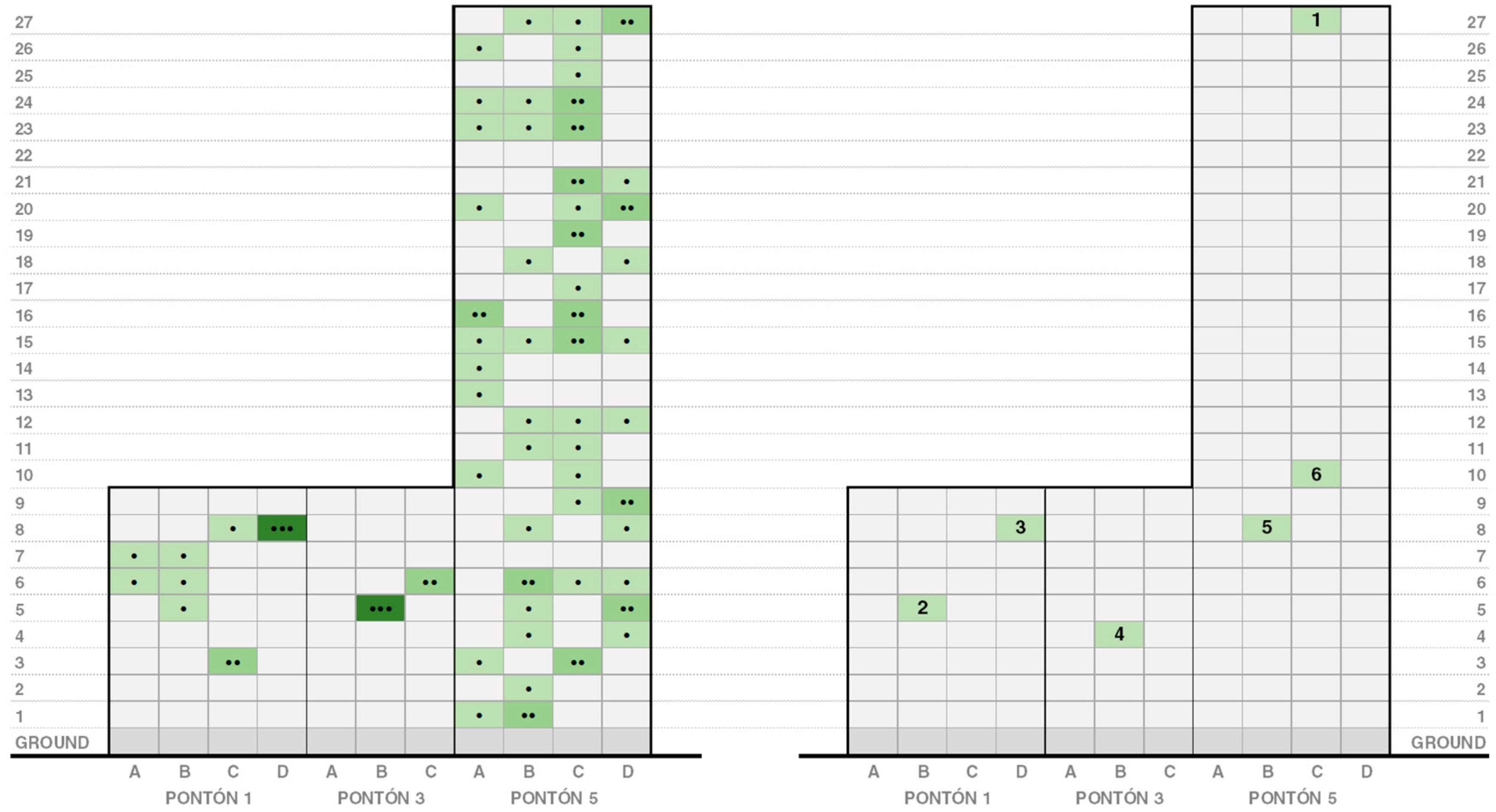
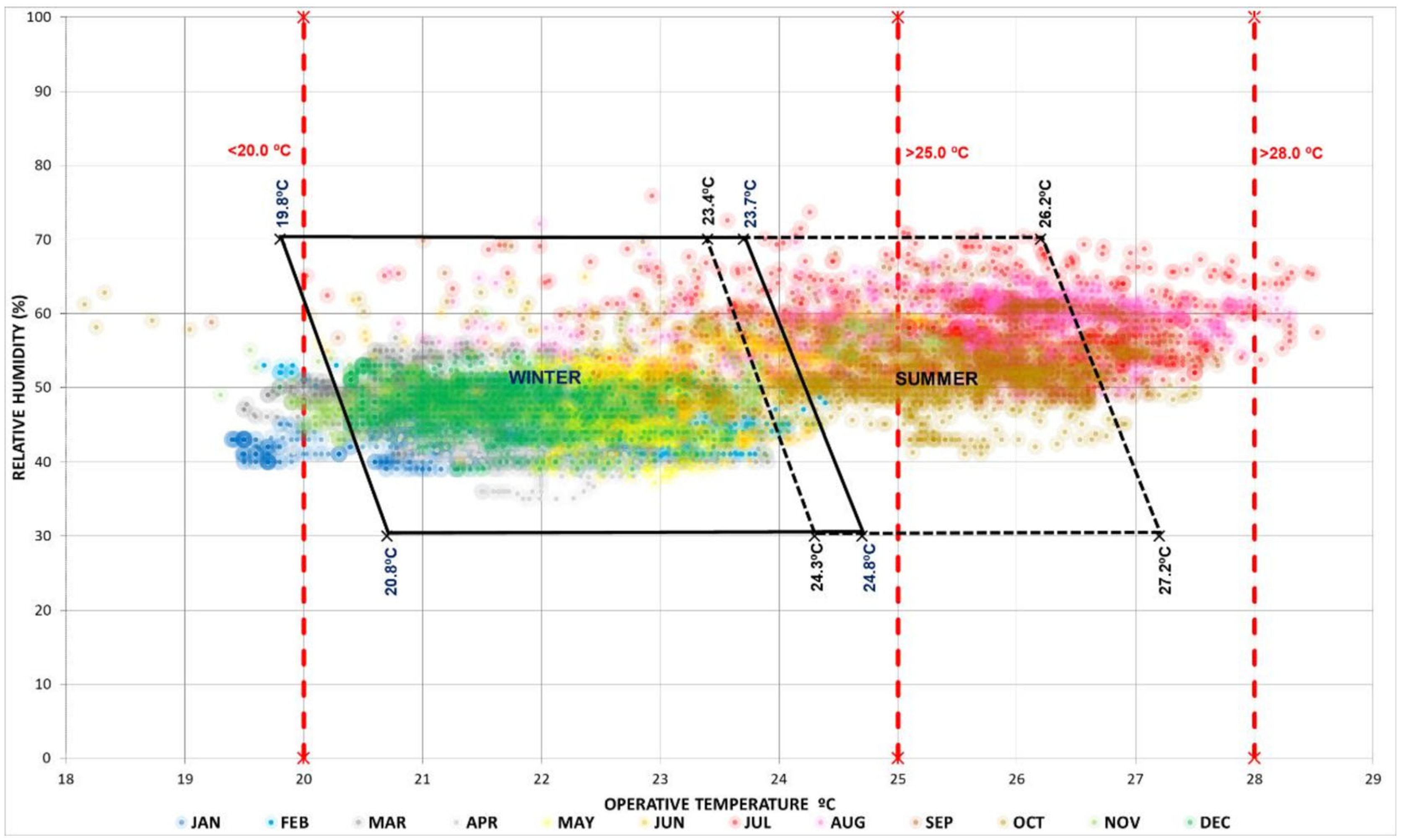
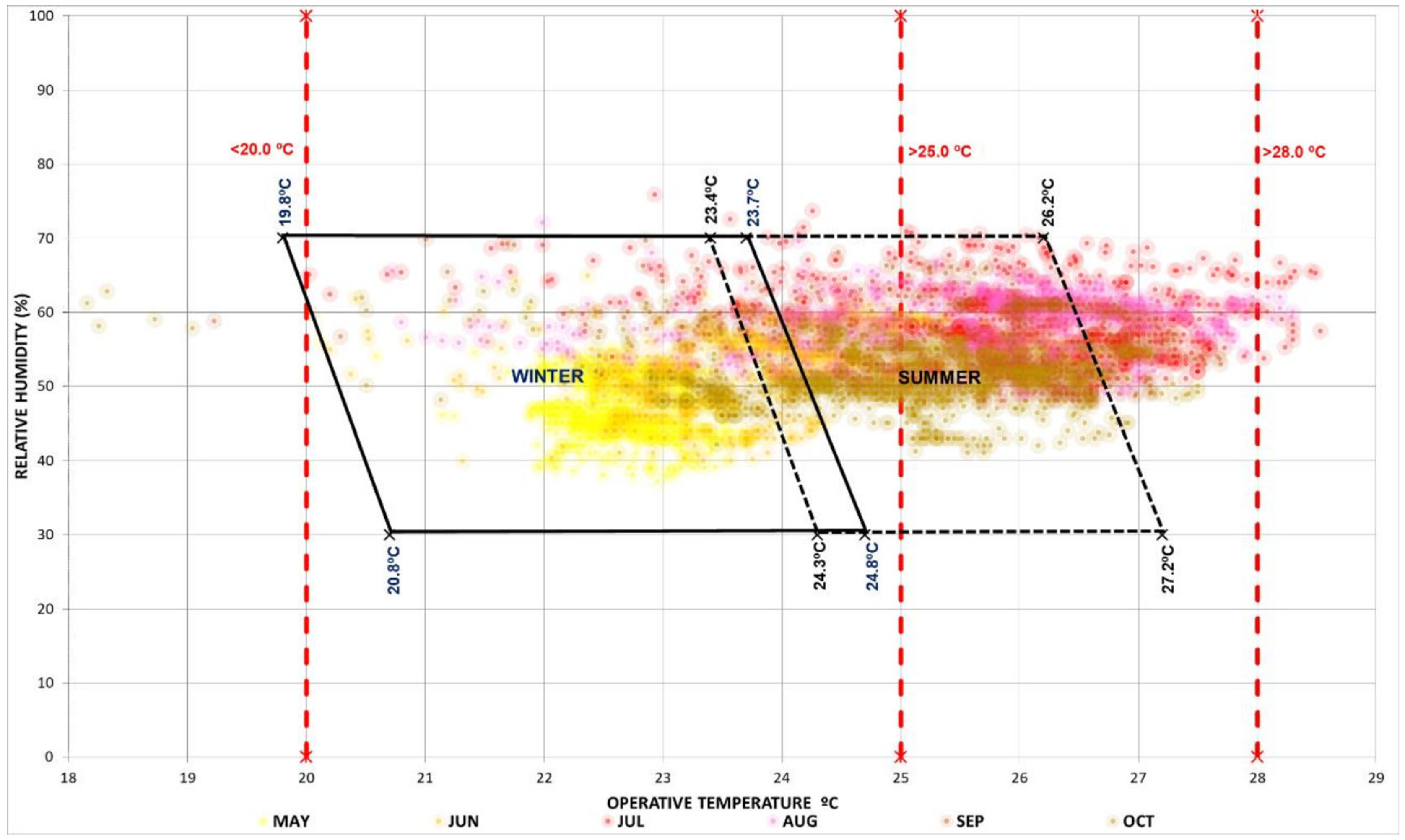
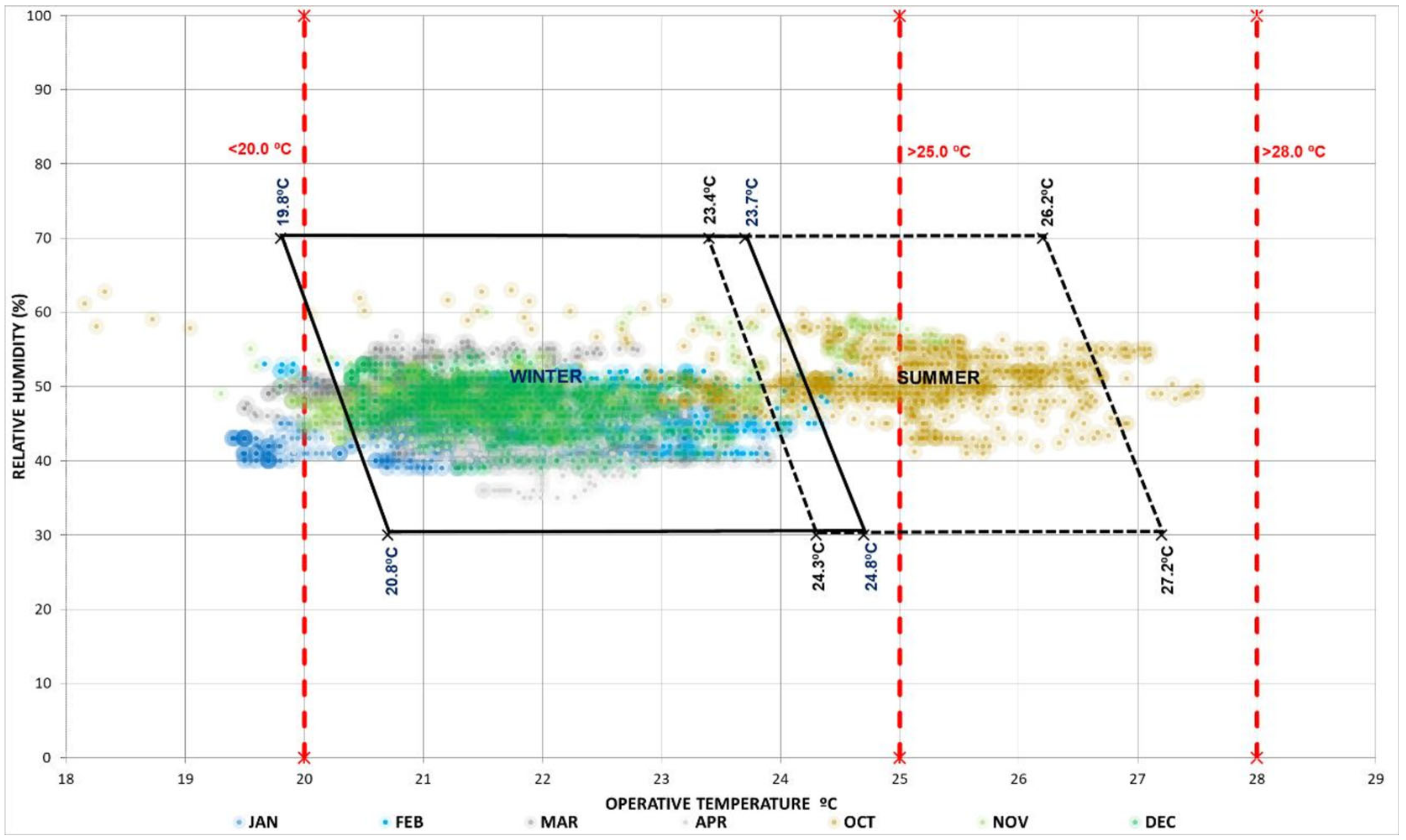



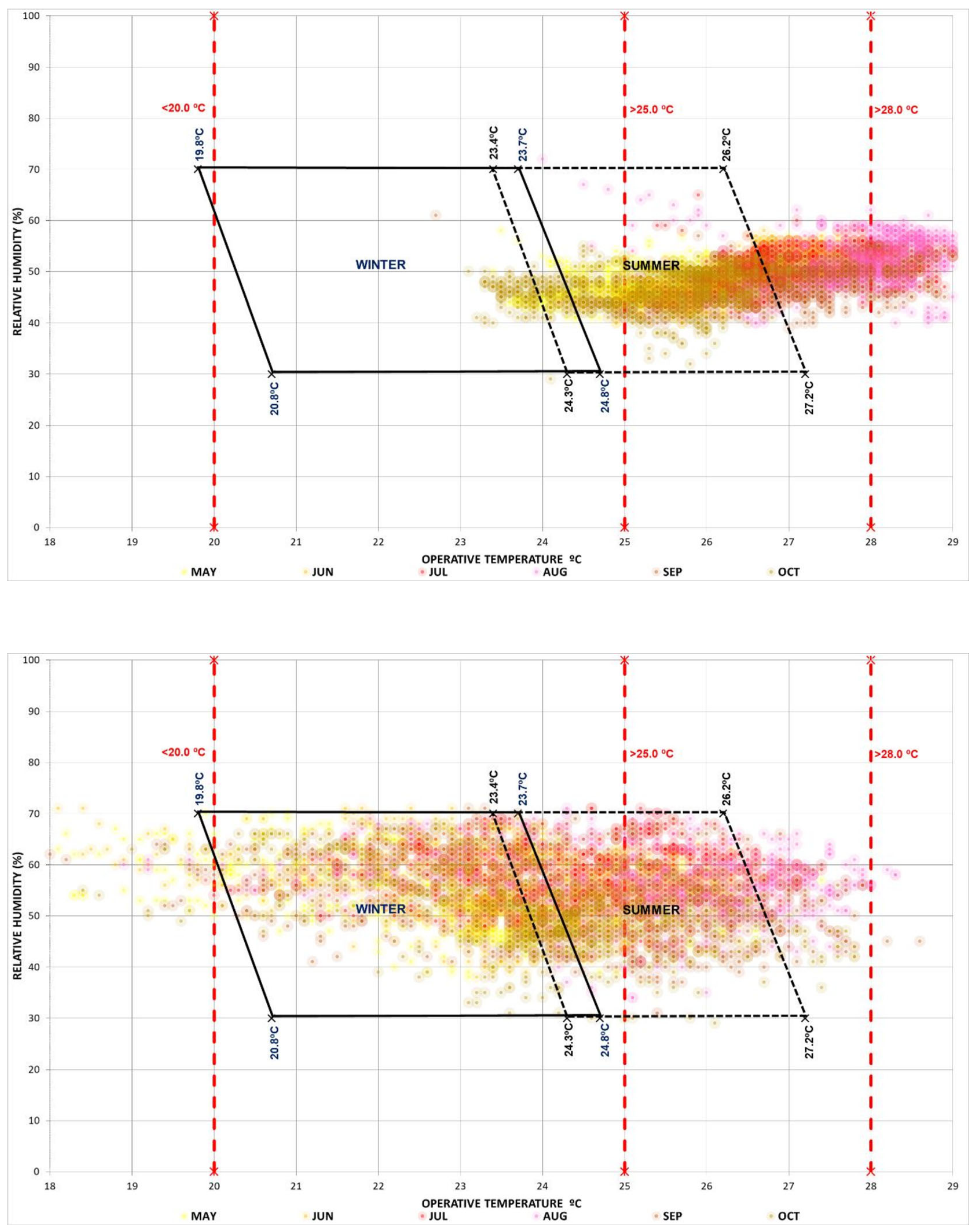
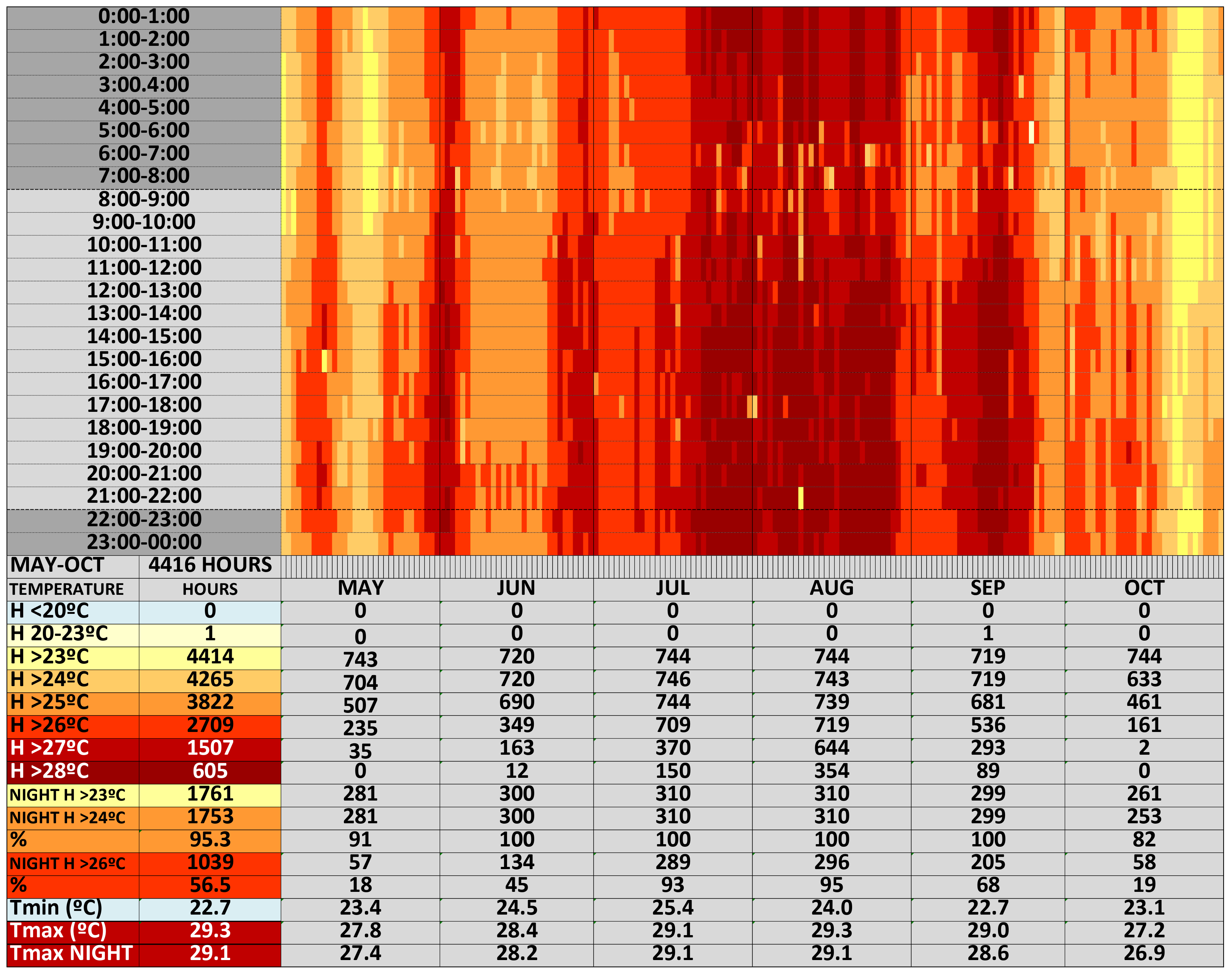


| Standard | Overheating Criteria |
|---|---|
| Passivhaus Institut | Limits number hours T > 25 °C Max. hours where T < 25 °C: 10%, recommends < 5% |
Number hours T > 25 °C
| |
| CIBSE Guide A [53] | Tmax 25 °C for living rooms and 23 °C for bedrooms Overheating when T > 28 °C 1% for living rooms and T > 26 °C 1% for bedrooms |
| ISO 7730 [50] | Predominantly mechanically ventilated buildings Rhmin = 40% and for maximum Rhmax = 60%
|
| EN 15251 [52] | Predominantly naturally ventilated buildings
Tcomf = 0.33 Trm + 18.8 + 2
Tcomf = 0.33 Trm + 18.8 + 3 When the upper temperature limits according to the categories cannot be guaranteed by passive means, mechanical cooling is unavoidable. |
| CIBSE TM:52 [54] | Predominantly naturally ventilated buildings
|
| CIBSE TM:59 [55] | Predominantly naturally ventilated buildings (a) Living rooms, kitchens and bedrooms: The number of hours during which ∆T is greater than or equal to a 1 K during the period from May to September will not be more than 3% of occupied hours. (CIBSE Criteria TM52 1: Hours of He Exceedance). (b) Bedrooms only: To ensure comfort during sleeping hours the operating temperature in the bedroom from 10 p.m. to 7 a.m. should not exceed 26 °C for more than 1% of the annual hours (32 h). Predominantly mechanically ventilated: Living rooms, kitchens and bedrooms: Annual hours ∆T > 1 K less than 3% of occupied hours |
| Dwelling | 1 | 2 | 3 | 4 | 5 | 6 |
|---|---|---|---|---|---|---|
| Monitoring start | March 2019 | August 2019 | August 2019 | August 2019 | January 2020 | January 2020 |
| Occupancy | 1p | 2p | 3p | 2p | 4p | 4p |
| Orientation | S-W | S-E | N-S | S | S | S-W |
| No. of orientations | 2 | 2 | 2 | 1 | 1 | 2 |
| Cross ventilation | Medium | Medium | High | No | No | Medium |
| Floor | 27th | 5th | 8th | 4th | 8th | 10th |
| SA, Suseful (m2) | 82.42 | 68.66 | 81.82 | 54.51 | 78,37 | 82.42 |
| No. of Bedrooms | 3 | 2 | 3 | 2 | 3 | 3 |
| No. of Bathrooms | 2 | 1 | 2 | 1 | 2 | 2 |
| Blind usage freq.1 | High | Low | Medium | High | Medium | Low |
| Window opening freq.1 | High | Low | High | High | High | Low |
| Summer | May | June | July | August | September | |
|---|---|---|---|---|---|---|
| Hours < 20 °C | 2525 (68.8%) | 697 (93.6%) | 562 (78.1%) | 357 (48.0%) | 388 (52.1%) | 521 (72.4%) |
| Hours >25°C | 265 (7.2%) | 12 (1.6%) | 48 (6.7%) | 82 (11%) | 91 (12.2%) | 32 (4.4%) |
| Hours >28 °C | 96 (2.6%) | 5 (0.7%) | 30 (4.2%) | 32 (4.3%) | 24 (3.2%) | 5 (0.7%) |
| Max. T. [°C] | 37.5 | 29.4 | 37.5 | 36.7 | 33.2 | 29.5 |
| Hours RH > 70% | 2670 (72.7%) | 522 (70.3%) | 502 (69.8%) | 561 (75.5%) | 552 (74.3%) | 533 (74.1%) |
| Max. RH [%] | 98.0 | 98.0 | 98.0 | 98.0 | 98.0 | 98.0 |
| Predominantly Naturally Ventilated 1 | ||||||||
|---|---|---|---|---|---|---|---|---|
| Dwelling | Category | Hours of Exceedance, He | Night hours T > 26 °C | Overheating 3 | ||||
| Hours | % | Limit | Hours | % | Limit | |||
| 1 | I | 2 | 0.0% | 3% | 274 | 8.4% | 1% | Yes |
| II | 0 | 0.0% | 3% | 274 | 8.4% | 1% | Yes | |
| Predominantly Mechanically Ventilated 2 | ||||||||
| Dwelling | Hours T > 26 °C | Overheating | ||||||
| Hours | % | Limit | ||||||
| 1 | 1125 | 12.84% | 3% | Yes | ||||
| Monitoring Period (1 April 2019–31 March2020) | |||||||||
| Dwelling | Temperature (°C) | Relative Humidity (%) | Absolute Humidity (g/kg) | ||||||
| Tmed | Tmin | Tmax | RHmed | RHmin | RHmax | Wmed | Wmin | Wmax | |
| 1 | 23.3 | 19.5 | 28.8 | 49 | 35 | 76 | 9.05 | 5.62 | 16.04 |
| Monitoring Period (1 October 2019–30 September 2020) | |||||||||
| Dwelling | Temperature (°C) | Relative Humidity (%) | Absolute Humidity (g/kg) | ||||||
| Tmed | Tmin | Tmax | RHmed | RHmin | RHmax | Wmed | Wmin | Wmax | |
| 1 | 23.2 | 16.4 | 29.1 | 51 | 36 | 77 | 9.34 | 5.63 | 15.59 |
| 2 | 24.6 | 19.4 | 29.3 | 47 | 29 | 72 | 9.24 | 4.47 | 15.90 |
| 3 | 23.4 | 18.2 | 28.3 | 50 | 26 | 77 | 9.19 | 4.30 | 16.69 |
| 4 | 23.9 | 15.8 | 28.8 | 49 | 23 | 76 | 9.02 | 4.44 | 14.87 |
| Monitoring Period (16 January 2020–30 September 2020)1 | |||||||||
| Dwelling | Temperature (°C) | Relative Humidity (%) | Absolute Humidity (g/kg) | ||||||
| Tmed | Tmin | Tmax | RHmed | RHmin | RHmax | Wmed | Wmin | Wmax | |
| 51 | 24.7 | 18.5 | 32.0 | 50 | 26 | 69 | 9.97 | 4.63 | 15.18 |
| 61 | 23.8 | 15.8 | 40.4 | 52 | 24 | 94 | 9.67 | 3.59 | 17.25 |
| Monitoring Period(1 April 2019–31 March 2020) | |||||||
| Dwelling | Hours 1 | % | Overheat. | Performance | Hours 2 | % | Humid. |
| 1 | 2170 | 24.0 | Yes | Catastrophic | 1000 | 11.4% | No |
| Monitoring Period(1 October 2019–30 September 2020) | |||||||
| Dwelling | Hours 1 | % | Overheat. | Performance | Hours 2 | % | Humid. |
| 1 | 2202 | 25.1 | Yes | Catastrophic | 1041 | 11.9% | No |
| 2 | 3858 | 44.0 | Yes | Catastrophic | 849 | 9.7% | No |
| 3 | 1143 | 13.0 | Yes | Poor | 858 | 9.9% | No |
| 4 | 1790 | 20.4 | Yes | Catastrophic | 627 | 7.2% | No |
| Monitoring Period(16 January 2020–30 September 2020)3 | |||||||
| Dwelling | Hours 1 | % | Overheat. | Performance | Hours 2 | % | Humid. |
| 53 | 2467 | 28.1% | Yes | Catastrophic | 1159 | 13.2% | No |
| 63 | 1547 | 18.8% | Yes | Catastrophic | 910 | 10.4% | No |
| Monitoring Period | |||||||||||
|---|---|---|---|---|---|---|---|---|---|---|---|
| (1 April 2019–31 March 2020) | (1 October 2019–30 September 2020) | (16 January 2020–30 September 2020) | |||||||||
| Year | Month | Dwe. | Year | Month | Dwelling | Month | Dwelling | ||||
| 1 | 1 | 2 | 3 | 4 | 5 | 6 | |||||
| 2020 | January | 0.0 | 2020 | January | 0.0 | 0.0 | 0.0 | 5.2 | January | 1.5 | 0 |
| 2020 | February | 0.0 | 2020 | February | 0.0 | 0.0 | 1.1 | 31.0 | February | 12.3 | 0.5 |
| 2020 | March | 0.0 | 2020 | March | 0.0 | 0.0 | 0.0 | 4.2 | March | 7.9 | 1.3 |
| 2019 | April | 0.0 | 2020 | April | 0.0 | 2.2 | 9.3 | 9.7 | April | 26.8 | 4.7 |
| 2019 | May | 0.0 | 2020 | May | 18.6 | 65.2 | 15.6 | 18.4 | May | 38.6 | 25.0 |
| 2019 | June | 15.7 | 2020 | June | 18.6 | 95.8 | 12.0 | 10.8 | June | 23.1 | 31.2 |
| 2019 | July | 83.6 | 2020 | July | 68.2 | 100.0 | 28.6 | 37.1 | July | 57.3 | 48.4 |
| 2019 | August | 70.3 | 2020 | August | 72.1 | 99.3 | 42.0 | 59.3 | August | 92.7 | 58.7 |
| 2019 | September | 74.3 | 2020 | September | 70.1 | 94.4 | 39.5 | 43.5 | September | 76.7 | 54.4 |
| 2019 | October | 50.1 | 2019 | October | 50.1 | 62.1 | 16.1 | 19.4 | October | X | X |
| 2019 | November | 1.1 | 2019 | November | 1.1 | 2.7 | 0.1 | 0.4 | November | X | X |
| 2019 | December | 0.0 | 2019 | December | 0.0 | 0.0 | 0.1 | 6.7 | December | X | X |
| 2019 | Year | 24.8 | 2019 | Year | 25.1 | 44.0 | 13.0 | 20.4 | Year | 28.2 | 18.8 |
| Monitoring Period(1 April 2019–31 March 2020) | ||||||
| Daytime Hours T > 25 °C (Living Rooms) | Daytime Hours T > 23 °C (Bedrooms) | Night Hours T > 24 °C (Bedrooms) | ||||
| Dwelling | Hours 1 | % | Hours 2 | % | Hours 3 | % |
| 1 | 1454 | 26.9 | 1346 | 41.3 | 1030 | 31.6 |
| Monitoring Period( 1 October 2019–30 September 2020) | ||||||
| Dwelling | Daytime hours T > 25 °C (living rooms) | Daytime hours T > 23 °C (bedrooms) | Night hours T > 24 °C (bedrooms) | |||
| Hours 1 | % | Hours 2 | % | Hours 3 | % | |
| 1 | 1427 | 26.3 | 1672 | 51.2 | 1183 | 36.2 |
| 2 | 2431 | 51.2 | 1932 | 67.9 | 1691 | 59.5 |
| 3 | 982 | 17.9 | 1494 | 45.5 | 671 | 20.4 |
| 4 | 1368 | 25.0 | 2437 | 74.2 | 1283 | 39.1 |
| Monitoring Period(16 January 2020–30 September 2020)4 | ||||||
| Dwelling | Daytime hours T > 25 °C (living rooms) | Daytime hours T > 23 °C (bedrooms) | Night hours T > 24 °C (bedrooms) | |||
| Hours 1 | % | Hours 2 | % | Hours 3 | % | |
| 54 | 1765 | 45.7 | 2122 | 91.7 | 1405 | 60.7 |
| 64 | 1146 | 29.7 | 1410 | 60.9 | 939 | 40.6 |
| Monitoring period(1 April 2019–31 March 2020) | |||||||
| Dwelling | Daytime Hours 1 T > 28 °C (living rooms) | Night Hours 2 T > 26 °C (bedrooms) | Overheating 3 | ||||
| Hours 1 | % | Limit | Hours 2 | % | Limit | ||
| 1 | 22 | 0.4 | 1% | 274 | 8.4 | 1% | Yes |
| Monitoring Period( 1 October 2019–30 September 2020) | |||||||
| Dwelling | Daytime hours 1 T > 28 °C (living rooms) | Night hours 2 T > 26 °C (bedrooms) | Overheating 3 | ||||
| Hours 1 | % | Limit | Hours 2 | % | Limit | ||
| 1 | 52 | 0.9 | 1% | 330 | 10.1 | 1% | Yes |
| 2 | 418 | 8.8 | 967 | 34.0 | Yes | ||
| 3 | 0 | 0.0 | 20 | 0.6 | No | ||
| 4 | 6 | 0.1 | 123 | 3.7 | Yes | ||
| Monitoring Period(16 January 2020–30 September 2020)4 | |||||||
| Dwelling | Daytime hours 1 T > 28 °C (living rooms) | Night hours 2 T > 26 °C (bedrooms) | Overheating 3 | ||||
| Hours 1 | % | Limit | Hours 2 | % | Limit | ||
| 5 | 224 | 5.8 | 1% | 396 | 17.1 | 1% | Yes |
| 6 | 187 | 4.8 | 166 | 7.2 | Yes | ||
| Monitoring Period (1 April 2019–31 March 2020) | ||||||||
| He 1 | Night Hours 2 T > 26 °C (Bedrooms) | |||||||
| Dwelling | Category | Hours 1 | % | Limit | Hours 2 | % | Limit | Overheating 3 |
| 1 | I | 2 | 0.0 | 3% | 274 | 8.4 | 1% | Yes |
| II | 0 | 0.0 | 274 | 8.4 | Yes | |||
| Monitoring Period (1 October 2019–30 September 2020) | ||||||||
| He 1 | Night hours 2 T > 26 °C (bedrooms) | |||||||
| Dwelling | Category. | Hours 1 | % | Limit | Hours 2 | % | Limit | Overheating 3 |
| 1 | I | 121 | 1.4 | 3% | 330 | 10.1 | 1% | Yes |
| II | 17 | 0.2 | 330 | 10.1 | Yes | |||
| 2 | I | 763 | 8.7 | 967 | 34.0 | Yes | ||
| II | 75 | 0.9 | 967 | 34.0 | Yes | |||
| 3 | I | 42 | 0.5 | 20 | 0.6 | No | ||
| II | 0 | 0.0 | 20 | 0.6 | No | |||
| 4 | I | 66 | 0.8 | 123 | 3.7 | Yes | ||
| II | 5 | 0.1 | 123 | 3.7 | Yes | |||
| Monitoring Period (16 January 2020–30 September 2020) 4 | ||||||||
| He 1 | Night hours 2 T > 26 °C (bedrooms) | |||||||
| Dwelling | Hours 1 | % | Limit | Hours 2 | % | Limit | Overheating 3 | |
| 54 | I | 178 | 2.0 | 3% | 396 | 17.1 | 1% | Yes |
| II | 44 | 0.5 | 396 | 17.1 | Yes | |||
| 64 | I | 216 | 2.5 | 166 | 7.2 | Yes | ||
| II | 126 | 1.4 | 166 | 7.2 | Yes | |||
| Monitoring Period (1 April 2019–31 March 2020) | ||||
| Dwelling | Hours 2 T > 26 °C | Overheating 3 | ||
| Hours 2 | % | Limit | ||
| 1 | 1125 | 12.8 | 3% | Yes |
| Monitoring Period (1 October 2019–30 September 2020) | ||||
| Dwelling | Hours 2 T > 26 °C | Overheating 3 | ||
| Hours 2 | % | Limit | ||
| 1 | 1070 | 12.2 | 3% | Yes |
| 2 | 2710 | 30.9 | Yes | |
| 3 | 350 | 4.0 | Yes | |
| 4 | 677 | 7.7 | Yes | |
| Monitoring Period (16 January 2020–30 September 2020) 4 | ||||
| Dwelling | Hours 2 T > 26 °C | Overheating 3 | ||
| Hours 2 | % | Limit | ||
| 54 | 1370 | 15.6 | 3% | Yes |
| 64 | 800 | 9.1 | Yes | |
| Monitoring Period (1 April 2019–31 March 2020) | |||||||||
| He 1 | We 2 | Tupp 3 | Overheating5 | ||||||
| Dwelling | Cat. | Hours 1 | % | Limit | Hours 2 | Limit | Hours 2 | Limit | |
| 1 | I | 2 | 0.0 | 3% | 0 | 6 | 0 | 0 | No |
| II | 0 | 0.0 | 0 | 0 | No | ||||
| Monitoring Period (1 October 2019–30 September 2020) | |||||||||
| Dwelling | Cat. | He 1 | We 2 | Tupp 3 | Overheating5 | ||||
| Hours 1 | % | Limit | Hours 2 | Limit | Hours 2 | Limit | |||
| 1 | I | 121 | 1.4 | 3% | 8 | 6 | 0 | 0 | No |
| II | 17 | 0.2 | 1 | 0 | No | ||||
| 2 | I | 763 | 8.7 | 46 | 0 | Yes | |||
| II | 75 | 0.9 | 6 | 0 | No | ||||
| 3 | I | 42 | 0.5 | 1 | 0 | No | |||
| II | 0 | 0.0 | 0 | 0 | No | ||||
| 4 | I | 66 | 0.8 | 4 | 0 | No | |||
| II | 5 | 0.1 | 0 | 0 | No | ||||
| Monitoring Period (16 January 2020–30 September 2020) 5 | |||||||||
| Dwelling | Cat. | He 1 | We 2 | Tupp 3 | Overheating5 | ||||
| Hours 1 | % | Limit | Hours 2 | Limit | Hours 2 | Limit | |||
| 5 | I | 178 | 2.0 | 3% | 13 | 6 | 3 | 0 | Yes |
| II | 44 | 0.5 | 3 | 0 | No | ||||
| 6 | I | 216 | 2.5 | 27 | 45 | Yes | |||
| II | 126 | 1.4 | 14 | 26 | Yes | ||||
Publisher’s Note: MDPI stays neutral with regard to jurisdictional claims in published maps and institutional affiliations. |
© 2020 by the authors. Licensee MDPI, Basel, Switzerland. This article is an open access article distributed under the terms and conditions of the Creative Commons Attribution (CC BY) license (http://creativecommons.org/licenses/by/4.0/).
Share and Cite
Rodríguez Vidal, I.; Otaegi, J.; Oregi, X. Thermal Comfort in NZEB Collective Housing in Northern Spain. Sustainability 2020, 12, 9630. https://doi.org/10.3390/su12229630
Rodríguez Vidal I, Otaegi J, Oregi X. Thermal Comfort in NZEB Collective Housing in Northern Spain. Sustainability. 2020; 12(22):9630. https://doi.org/10.3390/su12229630
Chicago/Turabian StyleRodríguez Vidal, Iñigo, Jorge Otaegi, and Xabat Oregi. 2020. "Thermal Comfort in NZEB Collective Housing in Northern Spain" Sustainability 12, no. 22: 9630. https://doi.org/10.3390/su12229630
APA StyleRodríguez Vidal, I., Otaegi, J., & Oregi, X. (2020). Thermal Comfort in NZEB Collective Housing in Northern Spain. Sustainability, 12(22), 9630. https://doi.org/10.3390/su12229630






